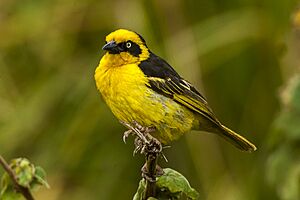Baglafecht weaver facts for kids
Quick facts for kids Baglafecht weaver |
|
|---|---|
 |
|
| ♂ P. b. subsp. reichenowi, Tanzania | |
| Conservation status | |
| Scientific classification |
The baglafecht weaver (Ploceus baglafecht) is a fascinating bird. It belongs to the Ploceidae family, which are often called weaver birds because of how they build their nests. You can find these birds living in different parts of eastern and central Africa. There are several groups of baglafecht weavers that live in separate areas. Each group can have slightly different feather patterns. Some even change their feathers when it's not breeding season!
Contents
What's in a Name? The Baglafecht Weaver's Story
The name "baglafecht" is a bit of a mystery! A famous French naturalist named Georges-Louis Leclerc, Comte de Buffon first used this name. He probably got it from a local name used in an old language from the Abyssinian region (modern-day Ethiopia).
Different Types of Baglafecht Weavers
Scientists recognize several different types, or subspecies, of the baglafecht weaver. Each one lives in a specific area:
- P. b. baglafecht - (Daudin, 1802): These live in the mountains of Ethiopia and southern Eritrea.
- P. b. neumanni - (Bannerman, 1923): You can find these in eastern Nigeria, Cameroon, and the Central African Republic.
- P. b. eremobius - (Hartlaub & Emin, 1887): They live in the north-eastern Democratic Republic of the Congo and south-western South Sudan.
- Emin's weaver (P. b. emini) - (Hartlaub, 1882): These are found in south-eastern South Sudan, south-western Ethiopia, and northern Uganda.
- Reichenow's weaver (P. b. reichenowi) - (Fischer, GA, 1884): They live in eastern Uganda, the Kenyan highlands, and northern Tanzania.
- Stuhlmann's weaver (P. b. stuhlmanni) - (Reichenow, 1893): These birds are found from the eastern Democratic Republic of the Congo to southern Uganda and western Tanzania.
- P. b. sharpii - (Shelley, 1898): They live in the mountain forests of southern and south-western Tanzania.
- P. b. nyikae - (Benson, 1938): You can spot these in the Nyika Plateau, which is in north-eastern Zambia and northern Malawi.
How to Spot a Baglafecht Weaver
The baglafecht weaver is about 15 cm (5.9 in) long. That's about the length of a pen!
Male Baglafecht Weavers
Adult male baglafecht weavers are easy to spot. They have a striking black "mask" on their face. This mask goes from their beak, around their eye, and covers their ear area. This black mask stands out against their bright yellow forehead, the top of their head, and their throat. Their upper body is yellowish-green. The feathers have dark centers, which makes them look a little streaky. Their chest is bright yellow, fading to white closer to their tail. Their tail is yellow with some dark brown. They have a black beak and pale yellow eyes.
Female and Young Baglafecht Weavers
Female baglafecht weavers do not have the black mask. Instead, they have a dusky (darkish) area around their eyes. The top of their head is yellowish-green, just like their upper body. When they are not breeding, the males lose most of their black mask. They will have a dusky area around their eye and their upper body turns grayish-brown. Their underside becomes white with a buff (light yellowish-brown) tint. Young birds and immature birds also do not have the black mask. Their heads are dark yellowish-green.
Interestingly, the original type of baglafecht weaver and Emin's weaver change their feathers for a distinct non-breeding look. But Reichenow's weaver does not!
Where They Live and What They Like
You can find baglafecht weavers in central, eastern, and south-eastern Africa. They like to live in places where forests meet open areas. You might also see them in woodlands, gardens, and even towns!
Baglafecht Weaver Habits
Baglafecht weavers usually build their nests alone, not in big groups or colonies. Their nests are made loosely and are often placed among the leaves of trees or bushes. These birds can be quite aggressive towards other birds. However, they are often not shy around people.
Images for kids




